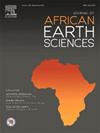基于遥感和地理信息系统的滑坡易感性地理空间分布建模
IF 2.2
4区 地球科学
Q2 GEOSCIENCES, MULTIDISCIPLINARY
引用次数: 0
摘要
在埃塞俄比亚,山体滑坡是一种突发的、危害极大的自然灾害。因此,本研究的重点是阿姆哈拉地区东部滑坡易发区的地理空间分布建模。考虑了滑坡的坡度、高程、坡向、曲率、TWI、SPI、河流距离、城镇距离、道路距离、降雨量、地形密度、排水密度、岩性、土壤、土地利用、土地覆盖等15个滑坡加重因素,建立了滑坡数值风险因子(LNRF)和层次分析法(AHP)模型。从LNFR和AHP模型的结果来看,约11.74%和13.94%的调查区域处于非常高的滑坡严重程度下,分别为8.79%和12.18%。采用受试者工作特征(Receiver Operating characteristic, ROC)曲线对两种模型进行评价,均获得较好的预测值,准确率分别为70.23%和64.47%。对于规划者、决策者和工程师来说,从LNRF和AHP中可以获得关于滑坡事件的宝贵信息,用于研究区域内的任何项目规划和开发。本文章由计算机程序翻译,如有差异,请以英文原文为准。
Geospatial distribution of landslide susceptibility modeling based on Remote Sensing and Geographic Information System
Landslides are an abrupt and highly harmful natural disaster in Ethiopia. So, this research focused on the geospatial distribution modeling of landslide susceptibility areas in the Eastern Part of the Amhara Region. The study considered fifteen landslide aggravating factors: slope, elevation, aspect, curvature, TWI, SPI, river distance, town distance, road distance, rainfall, lineament density, drainage density, lithology, soil, and land use land cover for Landslide Numerical Risk Factor (LNRF) and Analytic hierarchy process (AHP) model generation. From the LNFR and AHP model results, around 11.74 % and 13.94 % of the area under investigation was found under very high 8.79 % and 12.18 % under very low landslide severity levels, respectively. The Receiver Operating Characteristics (ROC) curve was implemented to measure the performance of the two models, and obtained good predictive values of 70.23 % and 64.47 % accuracy, respectively. Valued information for planners, policymakers, and engineers can be obtained from LNRF and AHP about landslide events for any project planning and development in the study area.
求助全文
通过发布文献求助,成功后即可免费获取论文全文。
去求助
来源期刊

Journal of African Earth Sciences
地学-地球科学综合
CiteScore
4.70
自引率
4.30%
发文量
240
审稿时长
12 months
期刊介绍:
The Journal of African Earth Sciences sees itself as the prime geological journal for all aspects of the Earth Sciences about the African plate. Papers dealing with peripheral areas are welcome if they demonstrate a tight link with Africa.
The Journal publishes high quality, peer-reviewed scientific papers. It is devoted primarily to research papers but short communications relating to new developments of broad interest, reviews and book reviews will also be considered. Papers must have international appeal and should present work of more regional than local significance and dealing with well identified and justified scientific questions. Specialised technical papers, analytical or exploration reports must be avoided. Papers on applied geology should preferably be linked to such core disciplines and must be addressed to a more general geoscientific audience.
 求助内容:
求助内容: 应助结果提醒方式:
应助结果提醒方式:


